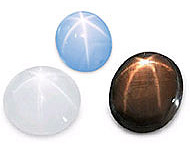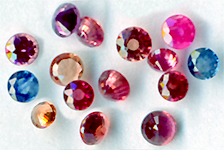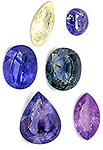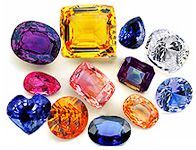SAPPHIRE



 Characteristics of the mineral.
Characteristics of the mineral.
Corundum (alumina-aluminum oxide Al2O3) with admixtures of titanium and iron. Chemically pure corundum is transparent and colorless. Corundum, which occupies second place in hardness and is inferior only to diamond in this respect, is widely known as sapphire (all colorless and colored stones except dark red) and ruby (dark red, chrome-colored) and holds the leading position among colored gems (Gems). These are common stones, especially in rings. Light red and dark pink stones are called pink sapphires, so there is a gradual imperceptible transition between them and rubies, but one can not unequivocally sharply distinguish these varieties. Colorless, unpainted and transparent sapphires are called leucosapphires, the latter, according to the standards, do not belong to the category of stones for which a license is required for trade.
Sapphire is one of the most perfect and dense structures of minerals. Although the lattice of space filling in the crystal of corundum and diamond is different, but the structures of both minerals are dense, highly symmetrical, then both minerals are hard (diamond - 10, corundum - 9), colorless and brightly sparkling. Absolutely pure corundum, consisting only of aluminum and oxygen, is colorless (leucosapphire). He looks like a diamond. They are not difficult to confuse. The border of leucosapphires is often surrounded in Burmese and Siamese products more expensive and spectacular stones. Leukosapphire glitters strongly, but does not "play". But the "game" of diamond is the most effective property: it breaks white light into the brightest spectrally pure sparks, flaring and fanning scattered around the faceted core. Therefore, sapphires most appreciate the color and quality of the coloring of the stones.
The fact that the blue color of sapphire is due to the presence of titanium in it is established in the synthesis of sapphires with the use of this element as a coloring material. The usual yellow color of sapphire is associated with the presence of iron oxide. Often there are also multi-colored stones. Heating usually leads to a lightening of the sapphire. Pale purple and yellow stones in this case lose their color, and dense purple stones acquire a pink color. X-ray irradiation makes the coloring deeper and more intense, even colorless stones can be colored. Starry sapphire has inclusions of rutile, which forms a three- or six-beam star, so they are cut with a cabochon. Pink, yellow, orange and green corundums are also called sapphires.
Opaque corundums of blue, gray-blue and gray-yellow color are found in nature much more often, respectively, and crystals of such substandard sapphire in both rocks and in mineral assemblages can be seen much more often than cut stones. They are very characterful and well remembered. Corundums are also formed in those parts of the rocks where granite magma is introduced into crystalline limestones; Such deposits are called skarns. Sapphire has uneven coloring, which reduces the price of a jeweler's stone. At a price, sapphires are comparable to diamonds.
Until the XIX century. Sapphires called all the blue stones, including lapis lazuli. At present, for noble varieties of corundum, the name of sapphires, only colored ones, is also fixed. The most valuable are the cornflower blue (Kashmiri, Burmese and Ceylon) sapphires. Sapphires with a greenish tint (Australian, Kenyan) are valued below. Rare stellate natural blue sapphires are of particular demand (they also have a synthetic analog). Refinement of corundum to improve color, transparency, etc. Is produced by heat treatment, irradiation or diffusion. Obladozhennye stones are very difficult to distinguish from stones with natural coloring.
When processing sapphire, use a stepped, diamond or combined cut (diamond top, stepped at the bottom). Less transparent stones, as well as stones with asterism or the effect of a cat's eye, caboshon. Color sapphires can be confused with other minerals and synthetic materials of a similar color. Diagnosis of them is done by physical properties and inclusions.
Among the stones of Sri Lanka, a significant proportion are milky blue sapphires. The magmatic type includes the Yogo-Galch deposit (Montana, USA). Small (no more than 2 carats) lamellar crystals of the sapphire of this deposit are from pale to cornflower blue or purple. The basalts are associated with the ruby and sapphire deposits of Australia (Queensland and New South Wales). Crystals of sapphires in the form of truncated pyramids with poorly expressed facets have different colors: green, orange-yellow, yellow sometimes with asterism, as well as stones with alexandrite effect; Stones of dark blue color differ sharply expressed dichroism in blue-green tones. Sapphire deposits are also found in Thailand (Siam) and Kampuchea. Sapphires of the Mogok ore mining district of Burma are associated with pegmatites. Indian deposits in the pc. Jammu and Kashmir have a pneumatolitic-hydrothermal genesis (in plagio-clasites, in marbles). Large crystals of sapphire are distinguished by blue, purple, green and yellow. The length of zoned crystals to 12.5 cm, width to 7.5 cm.
Magic properties of stones.
This stone-talisman strengthens the informal power of a person over other people, strengthens the spirit and is a stone of high-level teachers. Starry sapphire is a talisman of faith, hope and love, giving the person wisdom in achieving the goal. Sapphire gives fidelity, chastity, attracts friends, gives birth to modesty and truthfulness, drives away enemies - both visible and invisible. All the gems of the sapphire level (diamonds, beryl, etc.) are dangerous for their defects - cracks, spots, muddy areas. And we must remember that stones of good water, transparent, without defects are extremely rare in stores. As an amulet and amulet of sapphire drives away fears, it keeps from reservations, unjust courts, treachery and betrayal. In the east, sapphire has traditionally been considered a petrified drink of the gods, bringing them immortality, and sapphire bowls have improved, sometimes quite significantly, any contents poured into them. The stone is the mascot of prisoners, it helps them to free themselves and inclines the authorities to their side. It generally promotes the "opening" of any door, including the doors of life advancement, that is, it opens the way for a person, offering many options for personal development. Sapphire softens the wrath of the gods and is one of their favorite offerings. The stone activates the spirituality of the person, gives inspiration and sharpens the perception of the world. He connects man through communication with angelic essences with the whole cosmos, with the universe and leads to God. However, for the egoists and dark personalities the stone is completely useless and will not work for such a usurper.
Sapphire of deep blue color - "royal sapphire" grants its owner fidelity and modesty (if he is pure soul), helps prayer concentration. Therefore it is sometimes called a "stone of nuns", which cools passions and keeps chastity. Sapphire blue - a symbol of the soul, rushing into eternity. Blue sapphire is a stone of faithfulness, chastity and modesty (like other blue stones). It protects its owner from envy, heals from melancholy, cheers the heart, pleases feelings, attracts the mercy of fate and sympathy of others. A cold, dispassionate calm is blowing from the blue sapphires - something deep, dark to black, now as light as the transparent March ice under the cold skies of early spring. In ancient times it was considered a stone of contemplation, reflection, a symbol of the heavenly dome. Because it was especially appreciated by the ministers of religion. A special magical power is possessed by star sapphires from 3 and 6 intersecting lines resembling a snowflake, symbolizing magic numbers 3 and 6 (they are cut by a cabochon).
In ancient times, the blue sapphire was considered a seaman's stone, Believed that it helps to avoid shipwreck and cause the right wind. Sapphire is a talisman of lovers and newlyweds, brings happiness in love and keeps from slander. The talisman of the wise - arouses a thirst for knowledge, strengthens memory, strengthens prudence and discretion.







Poisonous and radioactive dangerous stones and minerals
** - poisonous stones and minerals (mandatory check in the chemical laboratory + explicit indication of toxicity).
** - radioactive stones and minerals (mandatory check on the standard dosimeter + ban on open sales in the case of radioactivity over 24 milli / g / h + additional measures of population protection).
All rare stones are subject to mandatory inspection at the standard dosimeter for the permissible level of radiation and in the chemical laboratory for the absence of poisonous and evaporating components that are dangerous to humans and the environment.


Comments
Commenting on, remember that the content and tone of your message can hurt the feelings of real people, show respect and tolerance to your interlocutors even if you do not share their opinion, your behavior in the conditions of freedom of expression and anonymity provided by the Internet, changes Not only virtual, but also the real world. All comments are hidden from the index, spam is controlled.